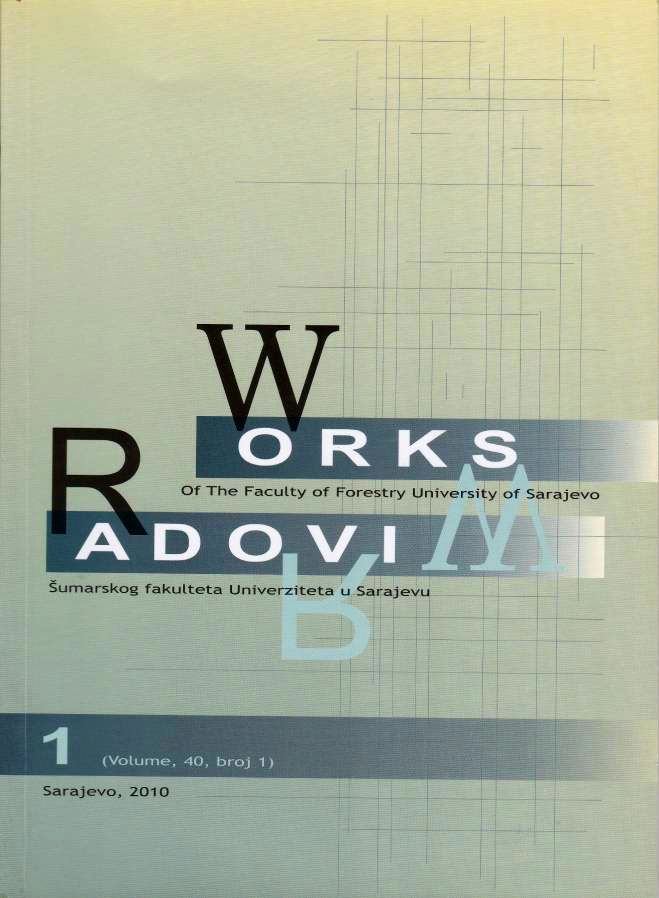Soil characteristics and water dynamics in selected land areas of Sub Mediterranean part of Bosnia and Herzegovina
DOI:
https://doi.org/10.54652/rsf.2010.v40.i1.157Keywords:
Karst, Soil, Water, Clime, MostarAbstract
UDK 582.632.2:630*81
Elevation interval in investigated area is 1552 m, with highest peak 1652 m above sea level in account: Veliko Ruište, Malo Rujište, Crna gora and slopes of Veleži. In mountain region, in lower hilly areas with interval from 700 m. s. l. to 250 m. s.l. from Podgorani village on the east, through Humi and Lišani village in central and south western part of area, to the end of area on Orlov kuk peak, on the west. Lowland area with altitude interval from 250 m. s. l. to 100 m. s. l. is form Salakovac village, over Prigrađani village on the east, across Željuša village in central part, with border line in Tršić Han and Potoci village, and road M-17, in the southern parts of analyzed area. Mountain, hilly and lowland zone, has specific karstified surface and underground (ČIČIĆ, 2002., KACER, 1926.), with caves and underground water flows. In hilly and lowland part of area exists fluvioglacial deposits with main characteristic as water retention systems (KACER, 1926.). In analysed area we identify the next type of soils: (i) lithosols, (ii) colluviums and (iii) alohtone terra rossa. Some important property for this soils are given (BASAGIC, AVDAGIĆ, SKOPLJAK,, CENGIC, et al, 2003.), including, mechanical structure and adsorptive complex. We analysed precipitation and temperature for 62 years period with presentation the next characteristics: (i) the tendency of precipitation (P), (ii) potential evapotranspiration (PET) for ten year period (1986.-1990.), (iii) trends of annual precipitation y =- 55.8 x +111938, (iv) tendency of the minimum amount of monthly rainfall y =- 9.28 x +18466, (v) the tendency of annual PET, y = 0.3 x +232, (vi) monthly trends of PET to July y = 5.1 x +9976.6. We were established a large annual average inputs of water, while their distribution on the basis PET and SET, very unfavourable for vegetation systems in the analyzed region. Represented soils and dynamic of water, expressed through the water regime, represent a frame in which real vegetation systems exist (STEFANOVIC, et al, 1983).
Downloads
References
BAŠAĆIĆ, M., SKOPLJAK, F., ČENGIĆ, I., et al. (2003): Zaštita voda izvorišta „Bošnjaci“, institut za Geologiju, Građevinski fakultet Univerziteta u Sarajevu, Sarajevo.
ČENGIĆ, I. (2004): Karakteristike geneze, evolucije i plodnosti pirogenih zemljišta na području tuzlanske regije. Doktorski rad. Sarajevo.
ČIČIĆ, S. (2002): Geologija Bosne i Hercegovine. Institut za geologiju Građevinskog fakulteta Univerziteta u Sarajevu. Sarajevo.
DREIBELBIS, F.R. (1954): Soil Type and Land Use Effects on Percolation of Soil Water Through Monolith Lysimeters. SSSA. Proc. No 18.
ĐOROVIĆ, M. (1986): Melioracije poljoprivrednih zemljišta - praktikum I, Beograd.
HAKL, Z. (1985): Kretanje vode i vodni bilansi u skeletnom i teškom tlu na području okoline Mostara, Doktorska disertacija, Univerzitet u Sarajevu, Sarajevo.
KACER, F., (1926): Geologija Bosne i Hercegovine. Državna štamparija u Sarajevu. Sarajevo.
MEHUYS, G.R., STOLZY, L.H., LATEY, J., WEEKS, L.V. (1975): Efect of Stones on the Hydraulic Conductivity of Relatively Dry Desert Soils. SSSA. Proc. No 39.
RESULOVIĆ, H., ČUSTOVIĆ, H., ČENGIĆ, I. (2008): Sistematika tla/zemljišta - nastanak, svojstva i plodnost. Univerzitet u Sarajevu. Sarajevo.
RESULOVIĆ, H., VLAHINIĆ, M., BURLICA, Č., HAKL, Z. (1976.): Problemi istraživanja
režima vlažnosti u skeletnim tlima. Vodoprivreda, No 39. Sarajevo.
RESULOVIĆ, H., VLAHINIĆ, M., HAKL, Z. (1975): Neke specifičnosti istraživanja skeletnih zamljišta, ANU SR BiH, Posebna izdanja, Vol. XIII. Sarajevo.
RESULOVIĆ, H., HAKL, Z. (1974): Valorizacija optimalne količine vode kod navodnjavanja poljoprivrednih kultura. Poljoprivredni fakultet, Sarajevo. Sarajevo.
RESULOVIĆ, H., VLAHINIĆ, M. (1973.): Some problems of Fertility of Skeleton Soil in Karstic Area of Herzegovina (Yugoslavia), Međunarodni simpozij o kompleksnim melioracijama pjeskovitih zemljišta, Bratislava.
RITCHIE; J.T. (1974): Evaluating Irrigation Needs for Southeastern USA, Irrigation and Drainage to World Food Supply, ASCE, Biuloxi. Mississipi.
RIVERS, A. D., SHIPP, R.F. (1972): Available Water Capacity of Sandy and Gravelly North Dacota Soils, SSSA Journal, No. 113.
STEFANOVIĆ, V., BEUS, V., BURLICA, Č., DIZDAREVIĆ, H., VUKOREP, I. (1983): Ekološko-
vegetacijska rejonizacija Bosne i Hercegovine. Šumarski fakultet Univerziteta u Sarajevu. Posebna izdanja, broj. 17. Sarajevo.
VLAHINIĆ, M. (1999.): Agrohidrološki parametri kao jedan od indikatora održivosti poljoprivrede, Academy of Science and Arts of Bosnia and Herzegovina, Special Publications, Vol. CIX. Pages, 45 - 60. Sarajevo.
VLAHINIĆ, M., et al (1982): Valorizacija optimalne potrošnje vode kod navodnjavanja poljoprivrednih kultura. Završni stručni izvještaj YU - AM Projekta. Sarajevo.
VLAHINIĆ, M. (1975.): Neki problemi vodnog bilansa tla u području Mostara, VI Savjetovanje o problemima voda i melioracija zemljišta na području krša. Vodoprivreda No 34. Split.
VLAHINIĆ, M., RESULOVIĆ, H., HAKL, Z. (1973.): Određivanje fizičkih svojstava u skeletnim tlima. Zemljište i biljka No 1 - 3. Beograd.
VLAHINIĆ, M., MUFTIĆ, H. (1972.): Poljoprivredne melioracije i uređenje zamljišta, Univerzitet u Sarajevu, Sarajevo.






















